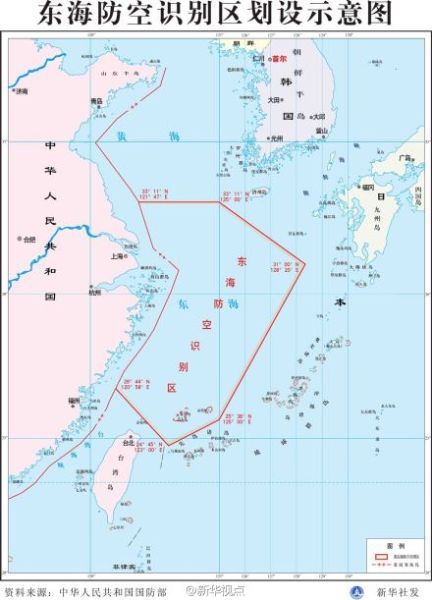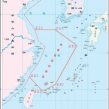
East China Sea Air Defense Moves: What for and Why Now?
Publication: China Brief Volume: 13 Issue: 24
By:

China’s declaration of an Air Defense Identification Zone (ADIZ) covering the disputed Diaoyu/Senkaku Islands—as well as the greater part of the East China Sea, including sections of Taiwan’s and South Korea’s own ADIZs—demands explanation. The announcement, issued by China’s Ministry of National Defense (MoD) on November 23, demands that aircraft entering the area report flights plans to, identify themselves to and follow the instructions of China’s MoD. The rules issued by the MoD imply a military threat to aircraft not recognizing Chinese authority over the zone, warning that China will undertake “emergency defensive measures” if aircraft fail to comply (MoD, November 23).
Official media have taken pains to downplay the significance of the move. Experts quoted in these media note that the ADIZ is not itself a claim of sovereignty over the disputed waters, and have noted the overlap with neighboring ADIZs. The overlap is described as coincidence rather than contradiction—Meng Xiangqing, a senior researcher at the National Defense University, recommends that aircraft enter the overlapping zones identify themselves to both countries involved (Xinhua, November 26). MoD spokesperson Yang Yujun also stressed that the ADIZ is aimed at “potential air threats.” “Normal flights by international air liners in the East China Sea Identification Zone will not be affected in any way,” he said (MoD, November 23). Yang dismissed U.S. protest over the establishment of the zone as “hypocritical,” fairly low in the taxonomy of Chinese political criticism.
China’s official response to U.S. defiance of the ADIZ should make it clear that the country is not seeking further confrontation. After two B-52s flew over the disputed islands without identifying themselves to Chinese authorities, MoD spokesperson Geng Yansheng suggested that it was enough that China had been able to identify the aircraft independently, a significant step away from the demand that aircraft identify themselves:
"We need to stress that China will identify every aircraft flying in the air defense identification zone according to the country’s announcement of aircraft identification rules for the air defense identification zone," Geng said. (Xinhua, November 27).
At least some Chinese analysts have framed the ADIZ as a step toward reducing tension in the East China Sea. Meng told Xinhua that “the zone will help reduce military misjudgment, avoid aerial friction and safeguard the flight order and safety” (Xinhua, November 25).
While the move is a continuation of recent escalation over the island conflict, it is also a substantial break from China’s practice over the past several years: rather than isolating Japan, it has forced responses from the United States, South Korea and Taiwan (Yonhap News, November 25; WantChinaTimes, November 26). The announcement also abandons the ambiguity Beijing has cultivated through irregular and unannounced visits to the disputed area, which has served to discourage coordinated response. Finally, the proactive measure makes it difficult for the PRC to sustain its account of itself as reacting to Japanese provocation.
This move is clearly calculated, planned at a high level and carefully timed. This raises two main questions: What is it meant to accomplish, and why now? In looking for answers to these questions, analysts should consider the following contexts:
Domestic Context
Coming immediately after the conclusion of the Third Plenum, a major meeting that set an ambitious—and politically challenging—agenda for reform, it is hard to see the timing as a coincidence (See China Brief, Vol. XIII, Issue 23). What the connection might be is less clear. The Plenum included language on national security, largely posed in the context of stability, but did not offer strategic guidance for international relations.
Tit for Tat
According to Chinese accounts, conflict over territorial disputes stems from foreign provocation—the recent rise of Diaoyu/Senkaku tensions in particular beginning with Japan’s move to “nationalize” the islands. The threat to planes visiting the East China Sea could be a response to Japan’s threat last month to shoot down military drones visiting the disputed area, which China described as showing that “Japan means to make provocations and create a tense atmosphere” (Xinhua, October 27). However, Chinese spokesmen are usually happy to draw connections like these, and they have not in this case.
Crisis Management
According to Chinese assessments, China’s 2012 seizure of the Scarborough Shoal “ended the history of the Philippines’ illegal harassment, inspections, and impounding of Chinese fishermen’s boats” (International Herald Leader, September 16; see China Brief, Vol. XIII, Issue 22 for additional context). While China paid a price in increased tensions, especially in terms of the Philippines’ decision to seek international arbitration over the dispute, its control of the reef has given it control over when incidents like the arrest of fisherman take place.
For a leadership that describes itself as managing a period of crisis in Chinese legitimacy, being able to avoid crises at critical moments may be more important than reducing them overall. Thus, it may be worth strained relations to impose a situation in which China can choose whether to respond to or tolerate another state’s actions rather than risking having a Chinese fisherman and a foreign navy start an unplanned incident.
Descriptions of the ADIZ as a step toward increasing stability—especially through reducing “military misjudgments” suggests a similar approach to the East China Sea.
Consolidating Gains
Finally, it is worth noting that Chinese assessments of recent standoffs with Japan suggest that China has made substantial progress, breaking Japan’s effective control (International Herald Leader, September 16). The declaration of an ADIZ may be an effort to define what China views as a new status quo, in which both nations are able to regularly challenge the other’s visits to the disputed area. Even if China is unable to win recognition for the zone, a situation in which the Chinese and Japanese militaries regularly challenge each other’s control is a step toward parity.





